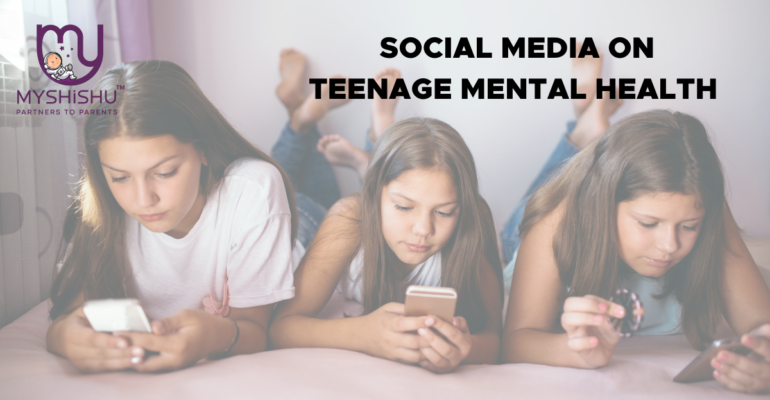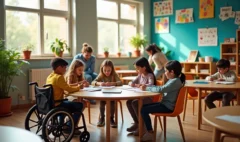The Impact of Social Media on Teenage Mental Health: Understanding the Risks and Benefits
The Impact of Social Media on Teenage Mental Health: Understanding the Risks and Benefits
Social media has become an undeniable force in our lives, especially as teenagers. It’s a platform for networking, creating and sharing information. But it’s too late to worry about the impact of social media on teen mental health. This blog explores both sides of the coin, exploring the potential risks and rewards that teens face in a digital landscape.
Table of Contents
The dark side on Teenage Mental Health: Risks and challenges
1. Curated perfection and body image articles:
Imagine looking at a photo album just filled with the best moments from other people’s vacations. Basically, that’s what social media feeds look like. People post the happiest experiences, vacations, and edited photos, giving them the illusion of a perfect life and a flawless body. Teens who are constantly exposed to this unrealistic image can experience feelings of inadequacy and low self-esteem. Research shows a link between spending too much time on social media and an increased risk of depression, anxiety and even eating disorders because teens feel pressured to conform to unrealistic beauty standards
2. Fear of missing out (FOMO) and social comparison:
There are always updates on what others are doing on social media. Friends can post pictures of parties, concerts, or exotic trips. This relentless flurry of “fun” can trigger FOMO (Fear of Missing Out) in teens. They feel abandoned and their own lives seem dull by comparison. This constant social comparison triggers feelings of loneliness and isolation, negatively affecting their psychological well-being.
3. Cyberbullying :
The anonymity of the Internet can embolden bullies. Cyberbullying can be more harmful than traditional bullying because it can be relentless and far-reaching. Hurtful comments, hurtful messages, and being excluded from the Internet can cause severe emotional distress for adolescents. In extreme cases, cyberbullying has also been associated with suicidal ideation (thoughts of suicide).
4. Sleep deprivation and screen addiction:
Social media platforms are designed to be addictive. Constant reporting, updates, and social acceptability can keep teens glued to their screens for longer periods of time. This excessive screen time disrupts sleep patterns. Sleep deprivation has a domino effect on mental health, affecting mood, concentration and overall well-being. Adolescents with insomnia often experience irritability, anxiety, and difficulty concentrating in school.
5. Improper exposure:
Social media isn’t always sunshine and rainbows. Teens can experience a wide range of inappropriate material, including violence, hate speech, and sexually explicit material. This exposure can upset emotions and cause feelings of anxiety and depression. It is important to remember that not everything on the Internet is true, and teens need guidance in navigating and filtering the information they find.

The interesting side of social media: Positive effects and opportunities
While social media presents challenges, it also offers benefits for teens. Let’s explore these positives:
1. Building social inclusion and community:
Social media platforms are the streets of the digital town for teenagers. They can communicate with distant friends, classmates, and even relatives. These connections help prevent loneliness and develop their own personality. Even teenagers can build online communities around all of their interests, hobbies, or fans. This will allow them to connect with like-minded individuals and develop support networks, which is especially helpful for those struggling with social anxiety or loneliness in their community
2. Self-expression and identity search:
Social media allows teens to express themselves creatively. They can share their thoughts, feelings and experiences through posts, photos, videos, or text. This self-disclosure can be a powerful tool for exploring identity. Teens can experiment with different online identities, allowing them to discover and hone their sense of self. In addition, interacting with others who share similar interests can boost self-confidence and foster a sense of independence.
3. Positive triggers include:
Social media isn’t just a preserve of perfection. There is plenty of good information and inspiration available. Teens can follow creators who promote self-love, mental health awareness, body positivity, or social activism. This positive message and exposure to role models can be encouraging and empowering. It can help teens develop a healthy body image, build self-esteem, and learn important life skills.
4. Access to information and support groups:
Social media can be a valuable resource for mental health information. Teens can access informative materials about various mental illnesses, coping strategies, and available resources. Forums can also refer them to online support groups where they can connect with others facing similar struggles. Sharing experiences and providing peer support can be a powerful tool for coping with mental health issues and feeling less alone.
5. Social activism and awareness raising:
Social media empowers youth to be agents of change. Platforms can be used to raise awareness about important social issues such as climate change, racial injustice, or mental health. Young people can participate in online campaigns, share information, and advocate for positive change. These social interventions foster a sense of purpose and empower youth to make a difference in the world.
Striking a balance: Tips for using social media effectively
- Mindfulness: Encourage teens to be critical of social media. Discuss the curated nature of online profiles and the importance of focusing on your journey.
- Set limits and boundaries: Set screen time limits and create low-tech environments, especially in the bedroom before bed. This promotes better sleep and reduces dependence on social media.
- Encourage real-world connections: Promote face-to-face connections and real-world activities in conjunction with online connections to foster positive relationships and positive life experiences.
- •Open communication: Create an open and supportive environment where teens feel comfortable discussing their online experiences, both positive and negative. Listen without judgment, and offer guidance when needed.
- Focus on the positive: Help teens monitor their social media feeds and focus on positive and motivating posts that promote self-esteem, psychological well-being, and why they care.
- Promote digital literacy: Teach teens about internet safety, responsible social media etiquette, and how to recognize and avoid cyberbullying. Encourage them to report any inappropriate behavior.
The role of parents, teachers and social media platforms
Parents and teachers play an important role in guiding teens to responsible and healthy social media use. Open communication, establishing boundaries and promoting digital literacy are key. Social media platforms also have a responsibility to create a safe online environment. This includes implementing stronger age proofs, effective anti-bullying strategies, and promoting mental health resources and support programs in their forums
Additional Common Questions
Q: Is social media bad for teens?
A: Social media has both positive and negative effects on teenagers. It can be a way to connect, be creative and share information, but it can also lead to body image issues, cyberbullying and sleep deprivation as well.
Q: How do I know if my teen’s social media use is a problem?
A: Signs of problematic social media use include:
Too much time spent on social media, neglecting other activities.
If you feel nervous or anxious after using social media.
Always compare themselves to others online.
Hard to fall asleep due to the late night timing of the film.
Experience with cyberbullying or cyberbullying.
Q: What can I do to help my teen use social media safely?
Have an open conversation: Discuss the risks and benefits of social media with your teen. Encourage them to become better users of the Internet.
Set boundaries: Set screen time limits and create low-tech environments, especially in the bedroom before bed.
Encourage balance: Encourage face-to-face and real-world activities to support their online lives.
Be informed: Learn about popular social media platforms and potential risks.
Support: Create a safe space for your teen to discuss positive and negative online experiences.
Conclusion
For teens, social media is a double-edged sword. By taking risks and rewards, we can empower them to navigate this digital space responsibly By promoting open communication, establishing boundaries, and digital literacy, we can helping young people use the positive aspects of social media, while minimizing potential risks. Ultimately, a healthy relationship with technology leads to positive psychological well-being and equips youth to succeed in a digitally connected world.
By working together, we can create safer and better online experiences for young people and nurture their psychological well-being











